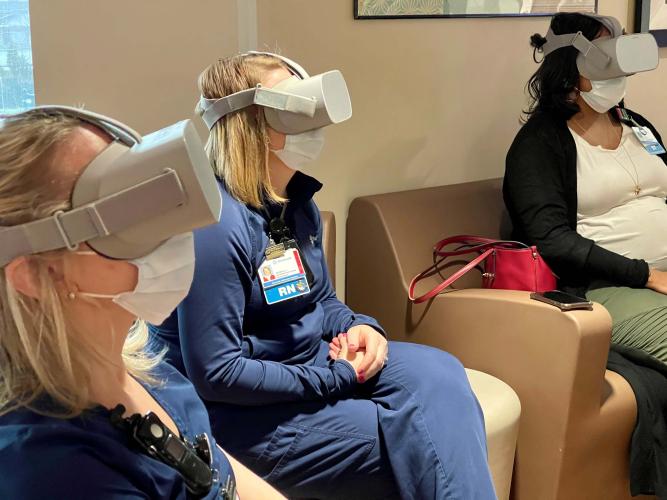
Ohio University collaborates to provide front-line health care workers with virtual reality simulation to help reduce stress

Researchers from Ohio University’s Game Research and Immersive Design (GRID) Lab and the Heritage College of Osteopathic Medicine have collaborated with OhioHealth to offer front-line health care workers in COVID-19 treatment units tranquil virtual reality simulations aimed at reducing stress.
A study about their results, published in PLOS ONE Journal, describes how creating a tranquil virtual reality (VR) experience set in nature can reduce the stress of health care workers amid the COVID pandemic.
Matt Love, virtual reality production coordinator for the GRID Lab; Carrie Love, GRID Lab contributor; and Elizabeth Beverly, Osteopathic Heritage Foundation Ralph S. Licklider, D.O., Endowed Professor in Behavioral Diabetes, as well as associate professor of primary care at the Heritage College, recognized early on in the pandemic that working on the front lines had negative impacts on the physical, social and emotional well-being of health care workers. In an effort to combat the high levels of stress, anxiety, depression and burnout health care workers were feeling, they created a Tranquil VR experience they believed could lower stress among front-line health care workers by immersing them in a tranquil nature scene.
“The Tranquil VR offers health care workers a brief respite during their workday,” Beverly explained. “The three-minute experience is designed to provide a few moments of rest and relief, and our research showed that the Tranquil VR did just that, lowering the health care workers’ subjective stress levels, with a very large effective size. This tells us that the Tranquil VR has very real practical applications for health care workers.”
The GRID Lab and Beverly partnered with OhioHealth to offer health care workers, whether they were direct care providers, indirect care providers, or support or administrative services staff, a chance to participate in the Tranquil VR simulation. Beverly oversaw the research portion of the project, working with OhioHealth to design the study, collect and analyze the data, and prepare the findings for dissemination. Meanwhile, the GRID Lab worked to bring the simulation itself to life.
To capture the experience, Matt Love with his GRID Lab colleagues John Bowditch, associate professor and director of the GRID Lab, and Jordan Herron, immersive media producer, worked with Nancy Stevens, distinguished professor of functional morphology and vertebrate paleontology in the Heritage College and director of the OHIO Museum Complex, to capture footage of a lush, green nature preserve in southeastern Ohio that is part of the OHIO Museum Complex. The GRID Lab was already collaborating on documenting the beauty of the preserve through all four seasons when the idea for the VR was created, so Stevens gave permission for them to use the preserve as the escape to bring to people.
“This project highlights the benefits of creative collaborations among museums, universities and health care organizations to promote the well-being of health care providers,” Stevens noted.
One hundred and two medical professionals were given a survey before and after doing the simulation to rate their stress. The results suggest that the application of this Tranquil VR simulation was effective in reducing stress among front-line health care workers in the short term.
“We knew early on in the pandemic that supporting well-being for our providers and associates was critical,” Dr. Laurie Hommema MD, FAAFP, OhioHealth Senior Medical Director, Well-Being said. “This virtual reality pilot and the partnership with Ohio University served as such a unique way to look at the full menu of offerings as we worked to find options for our teams working so hard to keep our patients and themselves healthy. We are encouraged by the feedback from our teams. Many of them found that being able to escape, even for a few minutes from the physical and emotional toll of reality during a pandemic, and the ability to step into this tranquil virtual space, could have benefits.”
Previously, the GRID Lab projects have focused on education; however, this was the GRID Lab’s first attempt at leveraging VR content for therapeutic purposes, specifically stress mitigation, and a project entirely different from ones created before.
According to Beverly, unlike previous projects she’s collaborated on with the GRID Lab, there is no script, no actors and no constructed narrative to follow. Instead the project immerses viewers in nature in its purest state. Viewers who participate in the Tranquil VR experience are surrounded by only nature and able to hear the sounds of leaves rustling in the wind, birds chirping and more.
“Like so many others, early on in the pandemic, it seemed as if there wasn’t anything that we could do other than stay home and constantly wash our hands,” Matt Love said. “Once this project came to life, it felt like we were shifting toward making a meaningful contribution, doing something to help. It still feels like a drop in the ocean, but given the results we’ve seen so far, I’m optimistic that it might become something more.”
Moving forward, the GRID Lab plans to continue collaborating with partners such as the Columbus Zoo and Columbus Symphony Orchestra on simulations that can reduce stress, offering a greater variety of Tranquil VR options for participants to experience. For instance, they are currently working on filming the sea lion tunnel at the Columbus Zoo, creating an experience where participants can watch the sea lions swim back and forth as they stand in the tunnel.
“I cannot say enough good things about the GRID Lab,” Beverly added. “The GRID Lab is the best group of people to collaborate with on campus, and I hope to work with them for the next 30 years. OhioHealth has also been an excellent partner in collaborating with us to try this new technology. Working with their team was so easy. This project demonstrates how much we can accomplish when we all work together to achieve the same goal.”
